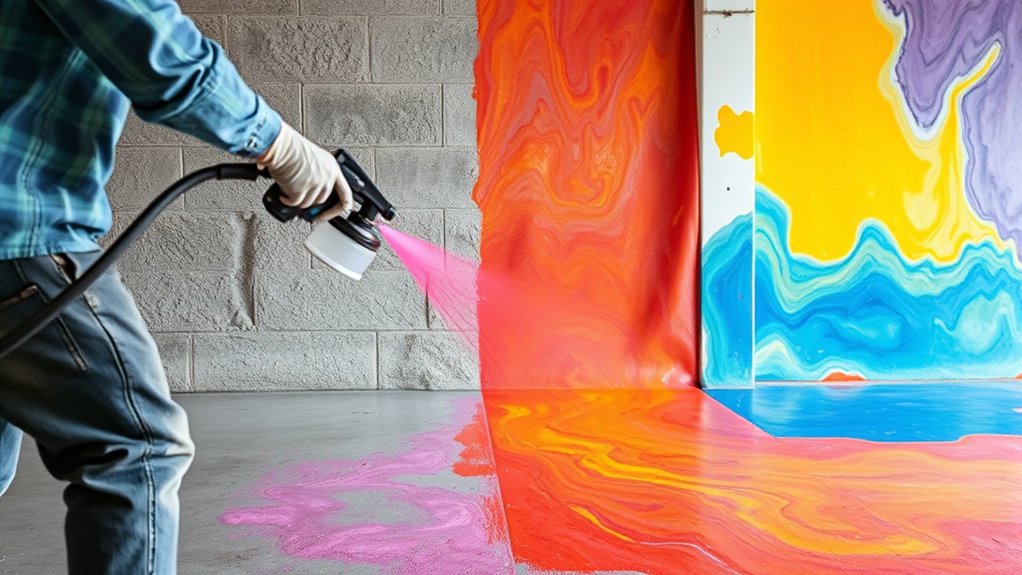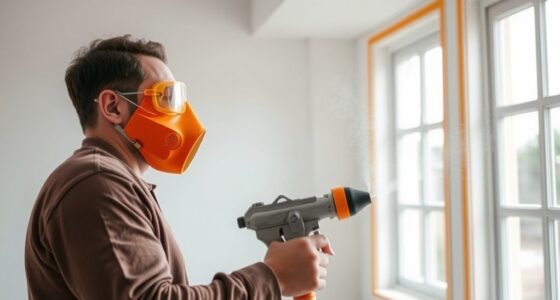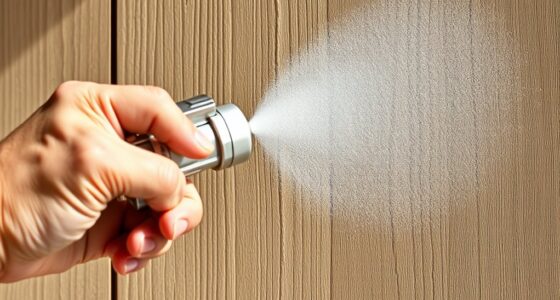Spraying concrete stain gives you a natural, textured finish that enhances the surface and provides long-lasting, UV-resistant color, ideal for outdoor spaces. In contrast, paint offers a vibrant, solid color that masks imperfections and creates a more uniform look, sometimes requiring more maintenance over time. Your choice depends on whether you want to highlight the concrete’s natural beauty or prefer a bold, consistent color. Keep exploring to discover how to achieve your perfect finish.
Key Takeaways
- Concrete stain penetrates deeply for a natural, textured finish, while paint provides an opaque, uniform color covering surface imperfections.
- Staining offers long-lasting, UV-resistant results that enhance concrete’s natural patterns, whereas paint may peel or fade over time.
- Spray staining involves thin, overlapping coats for even color; painting requires multiple coats and masking for solid coverage.
- Staining is less labor-intensive and better for highlighting texture; painting is quicker for vibrant, consistent colors and concealing flaws.
- Choose stain for durability and natural look; opt for paint when bold color and quick coverage of surface imperfections are priorities.

When it comes to enhancing the look of your concrete surfaces, choosing between spraying concrete stain and paint can be a essential decision. Both options can dramatically improve your space’s appearance, but understanding their application techniques and durability differences is fundamental to making the right choice. Spraying concrete stain involves applying a semi-transparent or translucent color that penetrates deeply into the concrete, highlighting its natural texture and pattern. To achieve a smooth, even finish, you should clean the surface thoroughly, repair any cracks or imperfections, and use a sprayer designed for concrete applications. Applying the stain in thin, overlapping coats ensures consistent coverage and vibrant color. Since stains penetrate the surface, they tend to resist peeling and flaking over time, making their application techniques more forgiving and less labor-intensive than paint. Proper surface preparation, such as cleaning and etching, is crucial for successful stain penetration and longevity.
Spraying concrete stain offers a natural, durable finish that penetrates deeply, highlighting texture and resisting peeling over time.
Paint, on the other hand, sits on top of the concrete surface, forming a protective film. When applying spray paint, you need to prepare the surface by removing dirt, oil, or old paint, then prime it to enhance adhesion. Use multiple light coats rather than a single heavy one to avoid drips and uneven coverage. Spray paint provides a solid, opaque color, masking imperfections more effectively than stain. Its application techniques require careful masking of surrounding areas to prevent overspray and ensure sharp lines, especially if you’re aiming for a specific design or pattern.
In terms of durability comparison, stains generally offer better longevity because they bond with the concrete and resist peeling, chipping, or flaking. They are also more resistant to UV damage and weathering, which makes them suitable for outdoor applications. Paint, while providing a more uniform and vivid color, tends to wear out faster, especially in high-traffic or exposed outdoor environments. It can peel or fade over time, requiring touch-ups or reapplication. However, paint can be more forgiving during application, especially if you need to cover surface imperfections or achieve a specific color consistency quickly.
Ultimately, your choice depends on your project goals. If you want a natural look with long-lasting color that enhances the concrete’s character, stain is the way to go. If you prefer a vibrant, solid color with easier coverage of surface flaws, paint might be your best bet. Whichever option you choose, mastering the appropriate application techniques and understanding their durability will ensure your project looks great and lasts for years.
Frequently Asked Questions
Can I Spray Concrete Stain or Paint on Sealed Surfaces?
You can spray concrete stain or paint on sealed surfaces, but sealing considerations are vital. First, make certain the surface is properly prepared by cleaning thoroughly and lightly sanding to remove any existing sealers or debris. This helps the stain or paint adhere better. Keep in mind that some sealers may prevent absorption, so test a small area first. Adequate surface preparation is key for a smooth, long-lasting finish.
What’s the Best Method for Achieving Even Coverage?
Think of your spray as a gentle breeze, evenly spreading color across your surface. To achieve perfect color consistency, use smooth, overlapping application techniques, maintaining a consistent distance from the surface. Keep your spray steady and avoid heavy layers. Regularly check your work, and adjust your technique as needed. This careful approach guarantees an even coverage that transforms your concrete into a beautiful, uniform masterpiece.
How Long Does Each Finish Typically Last Outdoors?
Concrete stain typically lasts 3 to 5 years outdoors, thanks to its superior UV resistance and color retention. Paint tends to last 5 to 10 years, but may fade or peel faster if exposed to harsh sunlight. If you want long-lasting results with vibrant color, paint is the better choice. However, for a more natural look that withstands weather, stain’s UV resistance and color retention make it a durable option.
Is Special Equipment Needed for Spraying Concrete Stain?
You’ll need some specialized application equipment to spray concrete stain effectively, but it’s not overly complicated. Before you begin, guarantee proper surface preparation to achieve a smooth, even finish. A quality sprayer with adjustable settings helps control the flow and coverage, making the process smoother. While it’s a bit of an art, with the right tools and prep, you’ll create a beautifully stained surface that transforms your space effortlessly.
Can I Switch From Stain to Paint Later Easily?
You can switch from stain to paint later, but it’s not always easy. Paint offers better durability, especially for high-traffic areas, and provides a wider range of color options. Before changing, make certain the stain is thoroughly cleaned and prepped, as paint may not adhere well to a stained surface. Keep in mind, removing stain might require stripping or sanding, making the transition more involved than you might expect.
Conclusion
Choosing between spraying concrete stain and paint is like picking the right brush for your masterpiece. Stain lets the concrete breathe and shows its natural beauty, while paint offers bold color and coverage. Think about your project’s look and longevity. Whichever you pick, you’ll be transforming your space—like adding a splash of personality to a blank canvas. Trust your instincts, and your concrete will tell its own unique story.
Franz came aboard the Paint Sprayer Zone team with a background in both journalism and home renovation. His articulate writing style, combined with a passion for DIY projects, makes him an invaluable asset. Franz has a knack for breaking down technical jargon into easy-to-understand content, ensuring that even the most novice of readers can grasp the complexities of paint sprayers.










